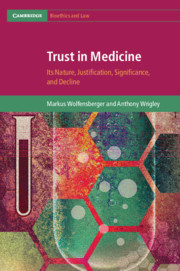Book contents
- Trust in Medicine
- Cambridge Bioethics and Law
- Trust in Medicine
- Copyright page
- Dedication
- Contents
- Figures
- Tables
- Preface
- Acknowledgements
- A Note on Usage
- Part I Introduction
- Part II The Nature of Trust
- 3 A Critical Analysis of Existing Definitions of Trust in Medicine
- 4 Proposing a New Type of Definition
- 5 A Pattern-Based Definition of Trust
- 6 Differentiating Trust from Related Concepts
- 7 Adapting the Definition of Trust to Different Situations
- Part III Justification of Trust
- Part IV Significance of Trust
- Part V The Decline of Trust
- Part VI Perspectives
- References
- Index
- Series page
4 - Proposing a New Type of Definition
The Pattern-Based Definition
from Part II - The Nature of Trust
Published online by Cambridge University Press: 19 August 2019
- Trust in Medicine
- Cambridge Bioethics and Law
- Trust in Medicine
- Copyright page
- Dedication
- Contents
- Figures
- Tables
- Preface
- Acknowledgements
- A Note on Usage
- Part I Introduction
- Part II The Nature of Trust
- 3 A Critical Analysis of Existing Definitions of Trust in Medicine
- 4 Proposing a New Type of Definition
- 5 A Pattern-Based Definition of Trust
- 6 Differentiating Trust from Related Concepts
- 7 Adapting the Definition of Trust to Different Situations
- Part III Justification of Trust
- Part IV Significance of Trust
- Part V The Decline of Trust
- Part VI Perspectives
- References
- Index
- Series page
Summary
In the previous chapter, the authors argued that there is no (and possibly cannot be a) comprehensive analytic definition of ‘trust’. In this chapter they claim that even if there is no comprehensive analytic definition of a term ‘X’, we can often recognise and understand ‘X’, and that one way of doing this is by recognising the pattern of characteristic features (or ‘family resemblance’) common to different examples of ‘X’. Moreover, they argue that whereas in a definition based on necessary conditions all conditions must be met, in a pattern-based definition not all features are essential, i.e., it may still be ‘X’ if not all features of the pattern of ‘X’ are present, but the better a case fits the pattern, the more likely it is ‘X’. Not only does this approach cohere well with approaches to medical diagnosis, but as a means of approaching how to provide a definition for a disputed term it is also philosophically underpinned by the work of Frank Jackson and Ludwig Wittgenstein.
- Type
- Chapter
- Information
- Trust in MedicineIts Nature, Justification, Significance, and Decline, pp. 31 - 38Publisher: Cambridge University PressPrint publication year: 2019

